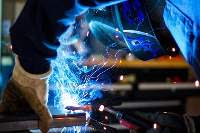
Welding

What is Welding?
Welding is a manufacturing process whereby two or more parts are fused together through heat, pressure, or both are involved in cold forming. Welding is commonly used on metals and thermoplastics, but can also be used on wood. The full welded joint can be referred to as a weld.
Some material requires the use of specific processes, techniques, and special skills to join two similar or dissimilar materials. Considered a number to be 'indecipherable', the term is not usually in dictionaries but is useful and descriptive in engineering.
The joining parts are known as the parent material. The material added to help join is called filler material or consumable material. The form of these materials may refer to them as basic plates or pipes, filler wires, consumable electrodes (for arc welding), etc.
You may also read
Visual inspection of the weld joint
What is Shielded metal arc welding (SMAW) welding?
Consumables are generally chosen to have the same composition as the original material, thus forming a homogenous weld, but there are occasions when welding is brittle when the filler is of a very different composition. Is and, therefore, properties are used. These welds are called asymmetrical.
Or, Welding is a fabrication process that connects materials, usually metals or thermoplastics, using high heat to melt the parts together and allow them to cool, leading to fusion. Welding is different from the lower temperature metal-joining techniques such as pin brazing and soldering methods, which do not melt the base metals.
In addition to melting the base metal, a filler material is usually added to the joint to form a molten material (the weld pool) that is cooled to form a joint, which weld configuration (butt, full penetration, fillet, etc., may be stronger than the base material (base metal). Pressure can also be used in combination with heat or to produce welds on their own. Welding also requires a shield form to protect the filler metals or molten metals from being contaminated or oxidized.
Many different energy sources may be used for the welding, including a gas flame (chemical), an electric arc (electrical), lasers, electron beams, frictions, and ultrasound. While often an industrial process, welding can be performed in many different environments, including in open air, underwater, and outdoor spaces. Welding is a dangerous undertaking and requires precautions to avoid exposure to burns, electric shock, vision damage, toxic gases and fumes, and intense ultraviolet radiation.
By the end of the 19th century, the only process of welding was forge welding, which the blacksmith used to heat iron and steel and mix it with a hammer. Arc welding and oxy-fuel welding were among the first processes developed late in the century, and electric resistance welding soon. Welding technology advanced rapidly in the early 20th century as world wars drove away from the demand for reliable and inexpensive joining methods.
After the wars, many modern welding techniques were developed, including manual methods such as shield metal arc welding, now one of the most popular welding methods, as well as semi-automatic and automated processes such as gas metal arc welding, submerged arc welding. Flux-red arc welding and electro slag welding. Development continued with the invention of laser beam welding, electron beam welding, magnetic pulse welding, and friction stir welding in the second half of the century. Today, as science continues to advance, robotic welding is common in industrial settings, and researchers continue to develop new welding methods and gain a greater understanding of weld quality.
How does welding work?
Metal joining
To resist brazing and soldering, which does not melt the base metal, welding is a high heat process that melts the base material. Usually with the addition of filler material.
Heat at high temperatures causes a weld pool of molten material to cool to join, which may be stronger than the parent metals. Pressure can also be used to produce welds, either with heat or by themselves.
It can also use a shielding gas to protects molten and filled metals from being contaminated or oxidized.
Plastic bonding
Plastic welding also uses heat to join the material (although not in the case of solvent weldings) and is achieved in three stages.
First, the surfaces are prepared and pressurized before the heat and, finally, materials are allowed to cool to create fusion. Methods of joining for the plastics can be separated into an external or internal heating method, that is depending on the exact process used.
Join wood
Wood welding uses heat generated by friction to join the materials. A great deal of pressure is applied to the joining material before a linear friction movement creates heat to bind the workpiece together.
Joint wood is a rapid process that allows the wood to attach without sticking or fingernails in a few seconds.
Post a Comment
Please do not enter any spam link in the comment box.